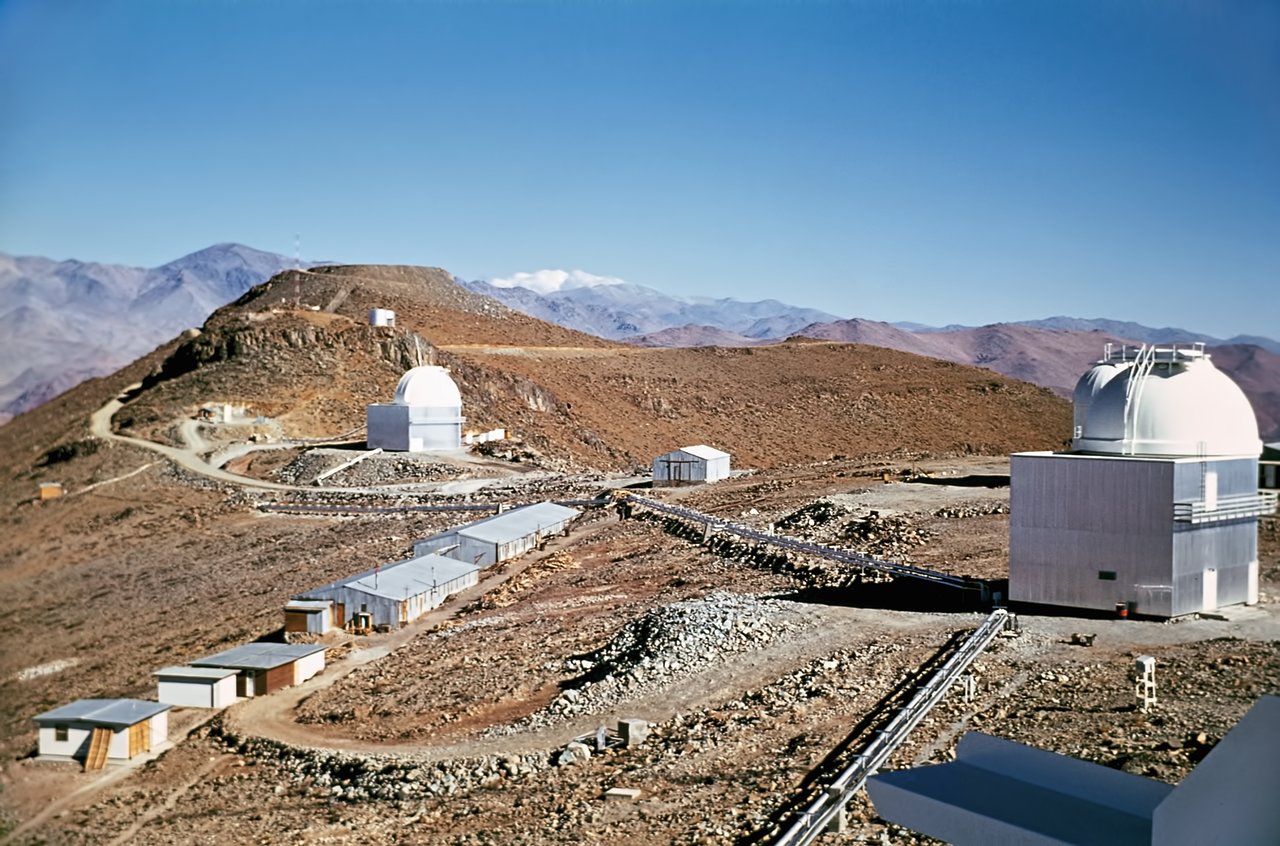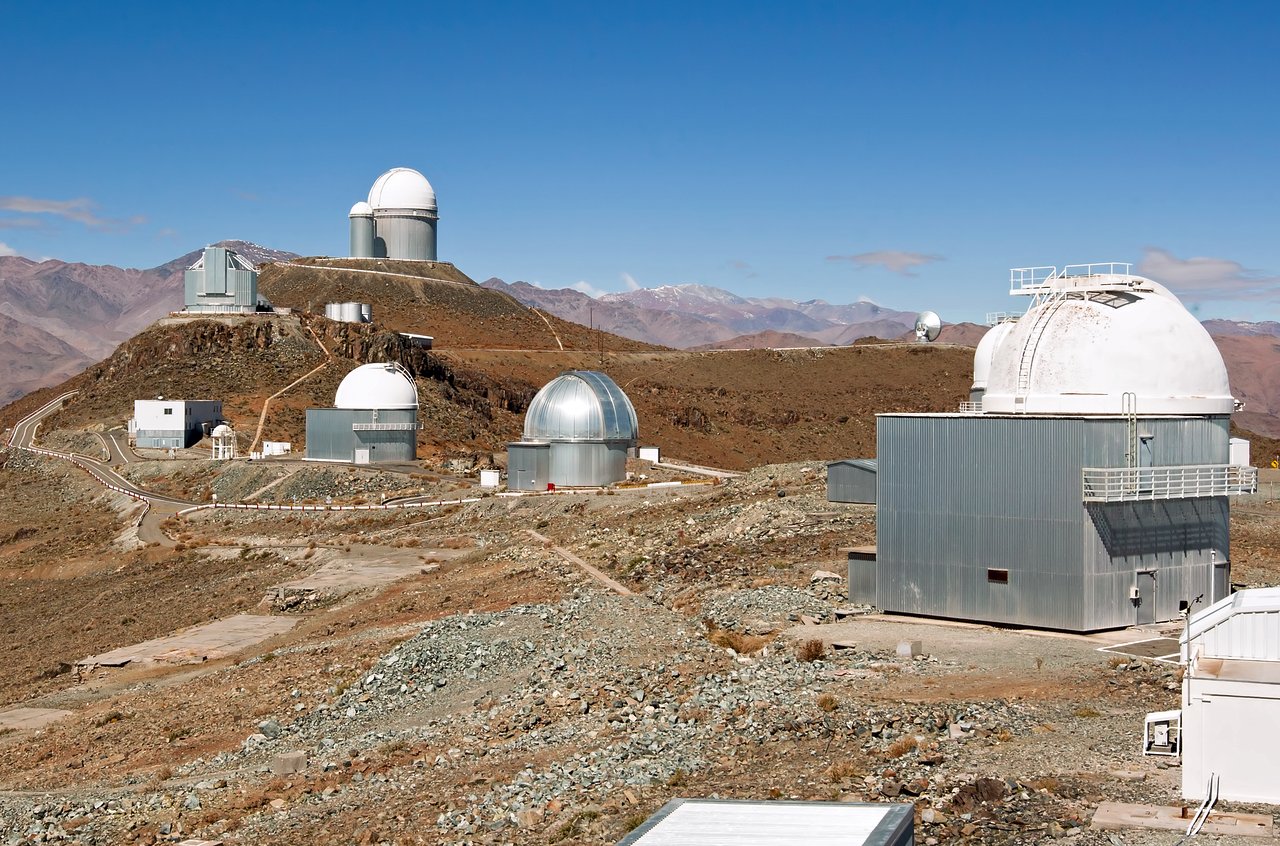Einblicke in die Vergangenheit - das La Silla-Observatorium damals und heute


Die ESO wird in diesem Jahr 50 Jahre alt, und um dieses wichtige Jubiläum zu feiern, werfen wir einen Blick in unsere Vergangenheit. Während des gesamten Jahres wird einmal pro Monat ein spezielles „Damals und Heute“-Bild der Woche illustrieren, wie sich die Dinge auf La Silla, am Paranal-Observatorium, in den ESO-Büros in Santiago de Chile und am Hauptsitz der ESO in Garching bei München über die Jahrzehnte verändert haben.
Unser erster Halt auf dieser Reise durch die Zeit ist La Silla, der erste Observatoriumsstandort der ESO. Die historische Aufnahme wurde Ende der 60er oder Anfang der 70er Jahre vom Kuppelgebäude des 1,52-Meter-Teleskops der ESO aus aufgenommen, das 1968 sein First Light hatte. Das zweite, aktuelle Bild zeigt, wie stark sich das Observatorium im Lauf der Jahrzehnte verändert hat. Im interaktiven Vergleichsbild lässt sich dies direkt sehen.
Auf dem historischen Foto sehen wir rechts im Vordergrund das 1-Meter-Teleskop der ESO und dahinter Teile des Grand Prism Objectif (GPO). Das dritte Teleskop auf dem Bild ist das 1-Meter-Schmidtteleskop auf der linken Seite. Dahinter erkennt man die Wassertanks des Observatoriums
Spult man die Zeit bis zum heutigen Tag vor, sieht man, wie La Silla sich weiterentwickelt hat. Viele weitere Teleskope sind hinzugekommen: Das 3,6-Meter-Teleskop der ESO und das benachbarte Coudé Auxiliary Telescope ragen nun vom Gipfel des Berges auf. Der eckige Schutzbau auf der linken Seite neben den Wassertanks gehört zum New Technology Telescope (NTT). Die Antennenschüssel des Schwedisch-ESO Submillimeterteleskops (SEST) mit 15 Metern Durchmesser schaut ganz rechts über den Horizont.
Das aktuelle Foto wurde von einer leicht geänderten Position auf dem Gebäude des 1.52-Meter-Teleskops aus aufgenommen, so dass das GPO vollkommen hinter dem 1-Meter-Teleskop verborgen ist. Der weiße Kuppelbau direkt hinter dem 1-Meter-Teleskop gehört zum dänischen 1,54-Meter-Teleskop. In der Bildmitte sieht man die silberfarbene Kuppel des MPG/ESO 2,2-Meter-Teleskops.
Während einige der gezeigten Teleskope, wie das 1-Meter- und das 1,52-Meter-Teleskop der ESO oder SEST nicht mehr in Betrieb sind, wird mit anderen nach wie vor an vorderster Front geforscht. Das 3,6-Meter-Teleskop ist mit dem HARPS-Instrument ausgerüstet, dem weltweit führenden Exoplanetenjäger (siehe eso1134 für einige der neuesten Ergebnisse). Das NTT war vor kurzem daran beteiligt, die Entstehung massereicher Sterne zu erklären (siehe eso1029). Beide Teleskope haben außerdem wichtige Daten zur Entdeckung der beschleunigten Expansion des Universums beigetragen – dafür wurde 2011 der Nobelpreis für Physik vergeben. Das MPG/ESO 2,2-Meter-Teleskop hat generiert einen ganz besonderen Datenschatz erzeugt: atemberaubende Weitfeldaufnahmen, mit denen sich Gammastrahlenausbrüche untersuchen lassen, die explosivsten Ereignisse im Universum überhaupt.
Links
- Die historische Aufnahme
- Die aktuelle Aufnahme
- Gegenüberstellung aktuelle und historische Aufnahme
- Weitere Informationen über La Silla
- Pressemitteilung von 2009 anläßlich des 40jährigen Jubiläums der Einweihung von La Silla (nur auf Englisch)
- ESO-Zeitleiste
Bildnachweis
ESO/J. Dommaget
Über das Vergleichsbild
| ID: | potw1201a |
| Veröffentlichungsdatum: | 3. Januar 2012 15:00 |
Bilder
Our use of Cookies
We use cookies that are essential for accessing our websites and using our services. We also use cookies to analyse, measure and improve our websites’ performance, to enable content sharing via social media and to display media content hosted on third-party platforms.
ESO Cookies Policy
The European Organisation for Astronomical Research in the Southern Hemisphere (ESO) is the pre-eminent intergovernmental science and technology organisation in astronomy. It carries out an ambitious programme focused on the design, construction and operation of powerful ground-based observing facilities for astronomy.
This Cookies Policy is intended to provide clarity by outlining the cookies used on the ESO public websites, their functions, the options you have for controlling them, and the ways you can contact us for additional details.
What are cookies?
Cookies are small pieces of data stored on your device by websites you visit. They serve various purposes, such as remembering login credentials and preferences and enhance your browsing experience.
Categories of cookies we use
Essential cookies (always active): These cookies are strictly necessary for the proper functioning of our website. Without these cookies, the website cannot operate correctly, and certain services, such as logging in or accessing secure areas, may not be available; because they are essential for the website’s operation, they cannot be disabled.
Functional Cookies: These cookies enhance your browsing experience by enabling additional features and personalization, such as remembering your preferences and settings. While not strictly necessary for the website to function, they improve usability and convenience; these cookies are only placed if you provide your consent.
Analytics cookies: These cookies collect information about how visitors interact with our website, such as which pages are visited most often and how users navigate the site. This data helps us improve website performance, optimize content, and enhance the user experience; these cookies are only placed if you provide your consent. We use the following analytics cookies.
Matomo Cookies:
This website uses Matomo (formerly Piwik), an open source software which enables the statistical analysis of website visits. Matomo uses cookies (text files) which are saved on your computer and which allow us to analyze how you use our website. The website user information generated by the cookies will only be saved on the servers of our IT Department. We use this information to analyze www.eso.org visits and to prepare reports on website activities. These data will not be disclosed to third parties.
On behalf of ESO, Matomo will use this information for the purpose of evaluating your use of the website, compiling reports on website activity and providing other services relating to website activity and internet usage.
Matomo cookies settings:
Additional Third-party cookies on ESO websites: some of our pages display content from external providers, e.g. YouTube.
Such third-party services are outside of ESO control and may, at any time, change their terms of service, use of cookies, etc.
YouTube: Some videos on the ESO website are embedded from ESO’s official YouTube channel. We have enabled YouTube’s privacy-enhanced mode, meaning that no cookies are set unless the user actively clicks on the video to play it. Additionally, in this mode, YouTube does not store any personally identifiable cookie data for embedded video playbacks. For more details, please refer to YouTube’s embedding videos information page.
Cookies can also be classified based on the following elements.
Regarding the domain, there are:
- First-party cookies, set by the website you are currently visiting. They are stored by the same domain that you are browsing and are used to enhance your experience on that site;
- Third-party cookies, set by a domain other than the one you are currently visiting.
As for their duration, cookies can be:
- Browser-session cookies, which are deleted when the user closes the browser;
- Stored cookies, which stay on the user's device for a predetermined period of time.
How to manage cookies
Cookie settings: You can modify your cookie choices for the ESO webpages at any time by clicking on the link Cookie settings at the bottom of any page.
In your browser: If you wish to delete cookies or instruct your browser to delete or block cookies by default, please visit the help pages of your browser:
Please be aware that if you delete or decline cookies, certain functionalities of our website may be not be available and your browsing experience may be affected.
You can set most browsers to prevent any cookies being placed on your device, but you may then have to manually adjust some preferences every time you visit a site/page. And some services and functionalities may not work properly at all (e.g. profile logging-in, shop check out).
Updates to the ESO Cookies Policy
The ESO Cookies Policy may be subject to future updates, which will be made available on this page.
Additional information
For any queries related to cookies, please contact: pdprATesoDOTorg.
As ESO public webpages are managed by our Department of Communication, your questions will be dealt with the support of the said Department.

